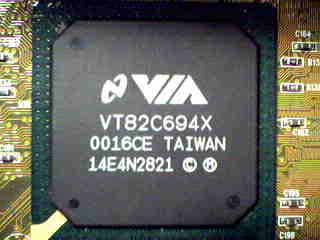MSI 694D Pro Dual Socket-370 Apollo Pro133A ATX
by Mike Andrawes on April 9, 2001 1:03 AM EST- Posted in
- Motherboards
Coordinating the CPUs: Apollo Pro133A
Compared to the i440BX, the 694X North Bridge of the Apollo Pro133A chipset brings support for 133MHz FSB Pentium III’s as well as AGP 4X.

The VIA 694X North Bridge
One of the nice things about the Apollo Pro133A is that it allows you to run your memory and FSB asynchronously; therefore, even if you are running your CPUs at 100MHz, you could still choose to run your memory at 133MHz for more bandwidth (1.06GB/sec vs. 800MB/sec), provided that your memory is capable of higher speed.
The Apollo Pro133A allows you to populate one or both CPU sockets. Unlike the ServerWorks chipset, you do not need a CPU terminator if you only want to use one CPU. All you need to do is make sure the CPU is installed in the socket labeled “CPU1”.
Because the 694D Pro was released last June, it still uses the good old VIA 686A South Bridge, instead of the newer 686B. The only real difference being that the 686B supports Ultra ATA 100, while the 686A tops out at Ultra ATA 66. Since at this point, the fastest hard drives in the market can only deliver sustained transfer rates of around 40MB/sec, so the 686A South Bridge is still enough. Of course, it’s just a matter of time before drives with higher sustained transfer rates starting appearing in the market, at which point the 686A could become a bottleneck.

VIA 686A South Bridge.
Just like most recent motherboards, two of the four USB ports are positioned at the back of the motherboard within the ATX I/O panel. The secondary USB header, which supports the third and fourth USB ports, is located in the front left hand corner of the board. MSI was among the first to include in the box the necessary USB bracket to take advantage of these extra USB ports, so it’s no surprise that it was included with the 694D Pro as well.
From the expansion slot perspective, the 5/1/0/1 (PCI/AGP/ISA/CNR) design is not particularly impressive, but should still be enough for most users. We have seen boards With the help of the 686A’s integrated PCI to ISA bridge, MSI could have included an ISA slot instead of the CNR slot, but chose not to do so as part of the push to leave legacy interfaces behind. The CNR slot, on the other hand, does help OEM builders to provide cheaper systems, although we have yet to see CNR devices widely available in the market.
For on-board audio, MSI chose the Winbond W83971D as the AC’97 audio CODEC. Once again, AC’97 host-based audio is capable of providing basic sound, but in order to obtain the highest performing and best sounding audio, we still recommend a good hardware-based PCI sound card.

W83971D AC97 CODEC.










0 Comments
View All Comments